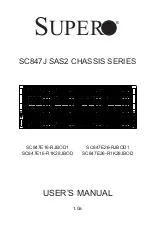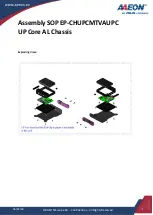
1-19
Cisco ASA Series CLI Configuration Guide
Chapter 1 Configuring Active/Active Failover
Configuring Active/Active Failover
Configuring Support for Asymmetrically Routed Packets
When running in Active/Active failover, a unit may receive a return packet for a connection that
originated through its peer unit. Because the ASA that receives the packet does not have any connection
information for the packet, the packet is dropped. This most commonly occurs when the two ASAs in an
Active/Active failover pair are connected to different service providers and the outbound connection
does not use a NAT address.
You can prevent the return packets from being dropped using the
asr-group
command on interfaces
where this is likely to occur. When an interface configured with the
asr-group
command receives a
packet for which it has no session information, it checks the session information for the other interfaces
that are in the same group. If it does not find a match, the packet is dropped. If it finds a match, then one
of the following actions occurs:
•
If the incoming traffic originated on a peer unit, some or all of the layer 2 header is rewritten and
the packet is redirected to the other unit. This redirection continues as long as the session is active.
•
If the incoming traffic originated on a different interface on the same unit, some or all of the layer
2 header is rewritten and the packet is reinjected into the stream.
Note
Using the
asr-group
command to configure asymmetric routing support is more secure than using the
static
command with the
nailed
option.
The
asr-group
command does not provide asymmetric routing; it restores asymmetrically routed packets
to the correct interface.
Prerequisites
You must have to following configured for asymmetric routing support to function properly:
•
Active/Active Failover
•
Stateful Failover—Passes state information for sessions on interfaces in the active failover group to
the standby failover group.
•
Replication HTTP—HTTP session state information is not passed to the standby failover group, and
therefore is not present on the standby interface. For the ASA to be able to re-route asymmetrically
routed HTTP packets, you need to replicate the HTTP state information.
You can configure the
asr-group
command on an interface without having failover configured, but it
does not have any effect until Stateful Failover is enabled.
Detailed Steps
To configure support for asymmetrically routed packets, perform the following steps:
Step 1
Configure Active/Active Stateful Failover for the failover pair. See the
.
Step 2
For each interface that you want to participate in asymmetric routing support, enter the following
command. You must enter the command on the unit where the context is in the active state so that the
command is replicated to the standby failover group. For more information about command replication,
see
hostname/ctx(config)#
interface
phy_if
hostname/ctx(config-if)#
asr-group
num
Summary of Contents for 5505 - ASA Firewall Edition Bundle
Page 28: ...Glossary GL 24 Cisco ASA Series CLI Configuration Guide ...
Page 61: ...P A R T 1 Getting Started with the ASA ...
Page 62: ......
Page 219: ...P A R T 2 Configuring High Availability and Scalability ...
Page 220: ......
Page 403: ...P A R T 2 Configuring Interfaces ...
Page 404: ......
Page 499: ...P A R T 2 Configuring Basic Settings ...
Page 500: ......
Page 533: ...P A R T 2 Configuring Objects and Access Lists ...
Page 534: ......
Page 601: ...P A R T 2 Configuring IP Routing ...
Page 602: ......
Page 745: ...P A R T 2 Configuring Network Address Translation ...
Page 746: ......
Page 845: ...P A R T 2 Configuring AAA Servers and the Local Database ...
Page 846: ......
Page 981: ...P A R T 2 Configuring Access Control ...
Page 982: ......
Page 1061: ...P A R T 2 Configuring Service Policies Using the Modular Policy Framework ...
Page 1062: ......
Page 1093: ...P A R T 2 Configuring Application Inspection ...
Page 1094: ......
Page 1191: ...P A R T 2 Configuring Unified Communications ...
Page 1192: ......
Page 1333: ...P A R T 2 Configuring Connection Settings and QoS ...
Page 1334: ......
Page 1379: ...P A R T 2 Configuring Advanced Network Protection ...
Page 1380: ......
Page 1475: ...P A R T 2 Configuring Modules ...
Page 1476: ......
Page 1549: ...P A R T 2 Configuring VPN ...
Page 1550: ......
Page 1965: ...P A R T 2 Configuring Logging SNMP and Smart Call Home ...
Page 1966: ......
Page 2059: ...P A R T 2 System Administration ...
Page 2060: ......
Page 2098: ...1 8 Cisco ASA Series CLI Configuration Guide Chapter 1 Troubleshooting Viewing the Coredump ...
Page 2099: ...P A R T 2 Reference ...
Page 2100: ......







































